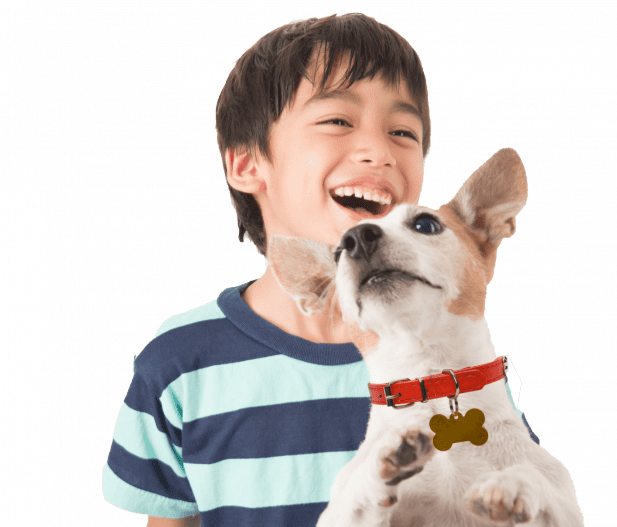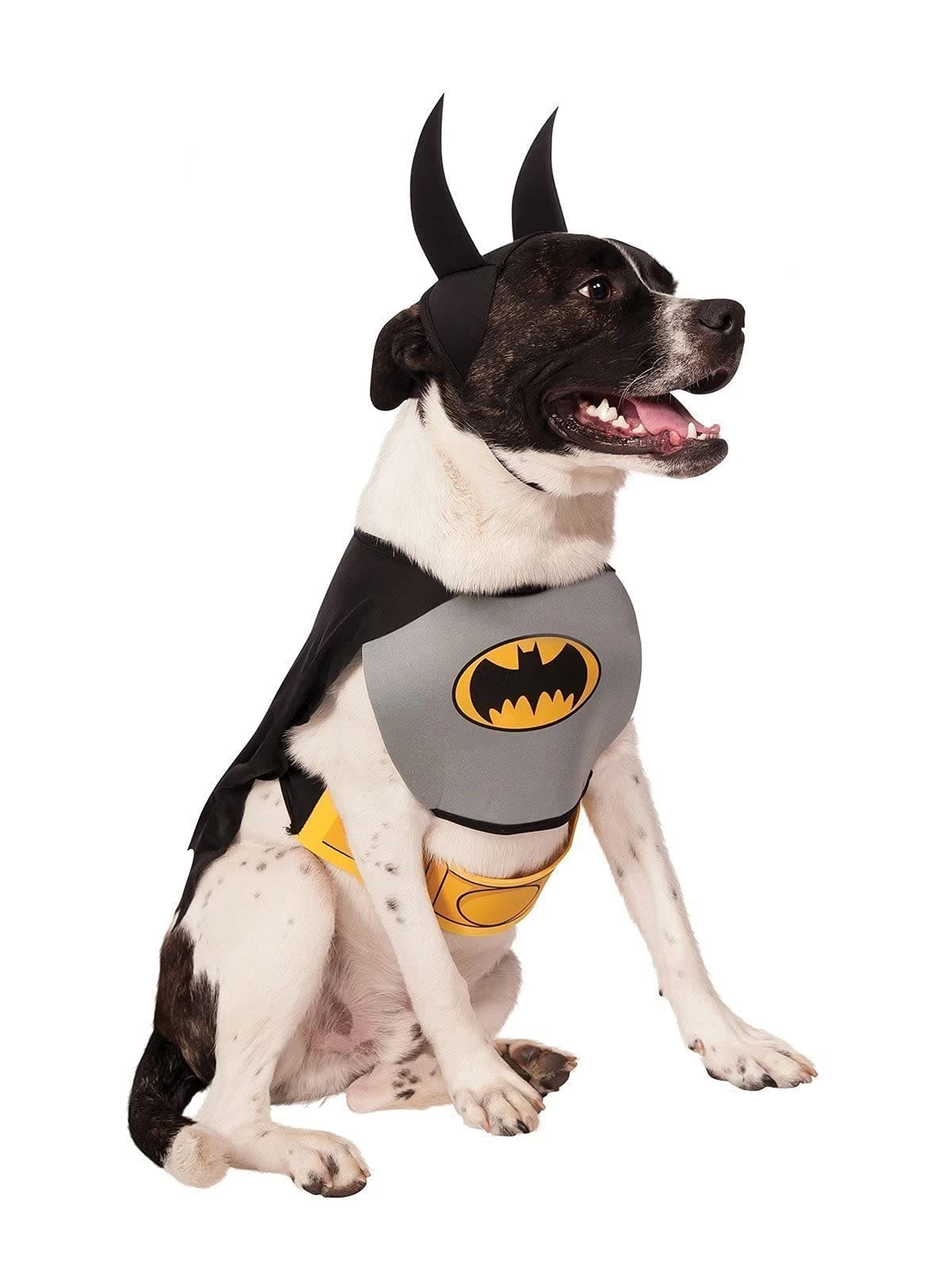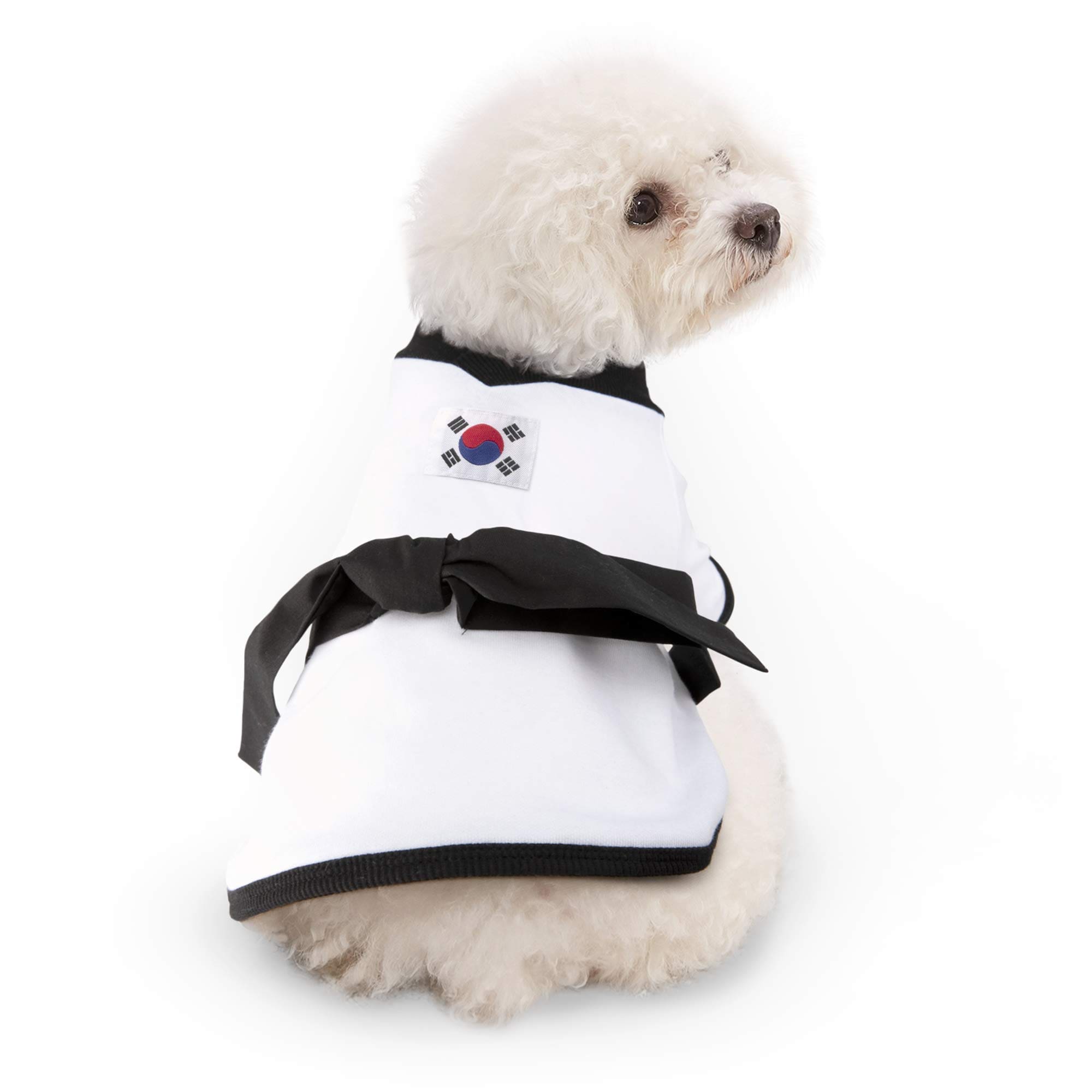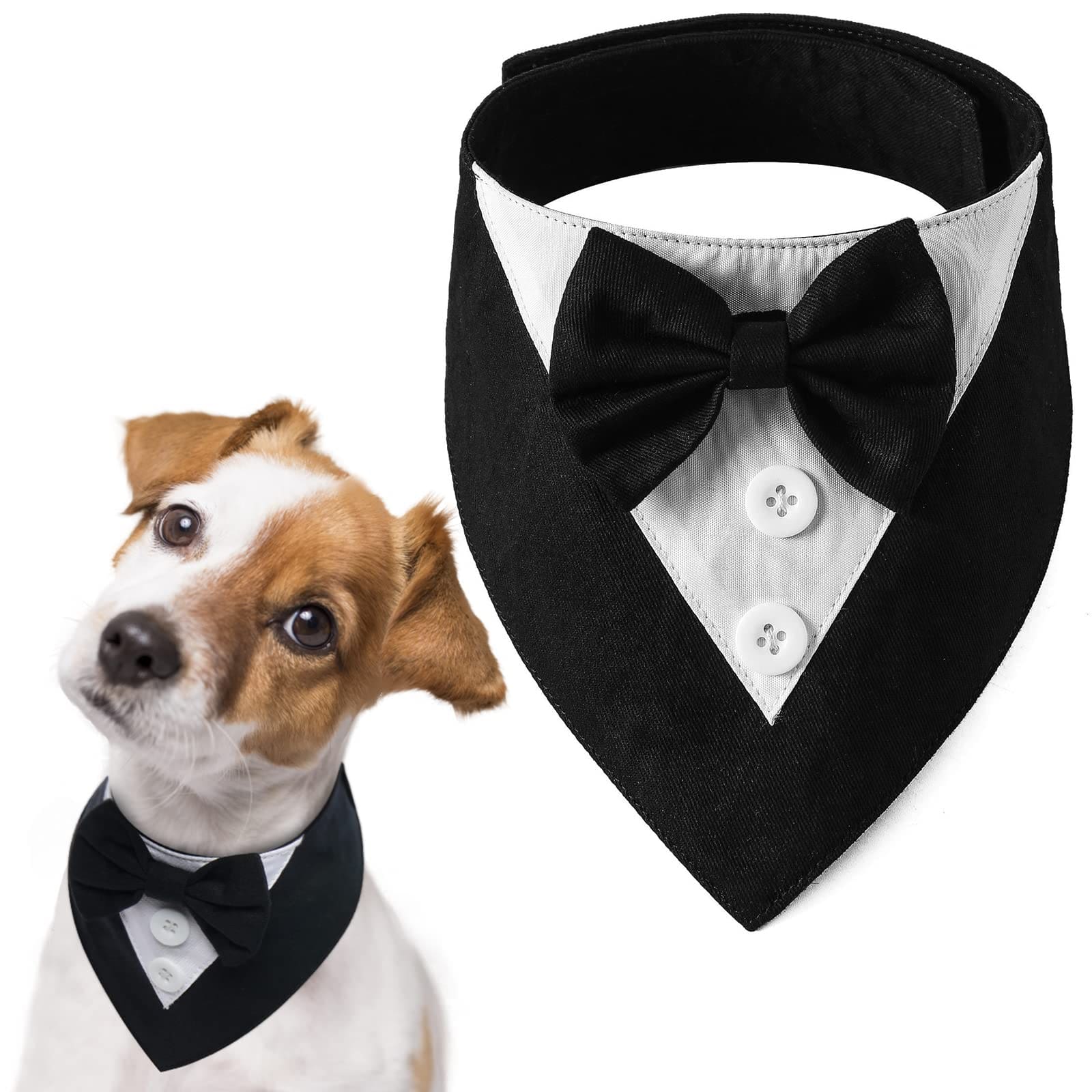Dog Breeds
Pet Costumes for Dogs: 7 Adorable Outfit Ideas for Your Furry Friend
Pet costumes for dogs can bring a lot of fun and joy. Whether you’re dressing up your furry friend for Halloween, a themed party, or just because, there are endless costume options available.
From superheroes to movie characters, dogs can join in on the fun and be the center of attention. It’s a delightful experience to see our pets dressed up and having a good time.
When buying a costume for your dog, there are several things to keep in mind. The most critical aspect is the fit.
Costumes that are too tight can be uncomfortable for your dog, and too loose ones might trip them up.
Paying attention to the material is also important; it should be soft and non-irritating. Look out for costumes with easy-to-use fastenings to make dressing up your dog a hassle-free process.
We spent countless hours researching and testing various dog costumes to find the ones that are both adorable and comfortable for your pet.
Listen to the Article
Best Pet Costumes for Dogs
Let’s dress up our furry friends and make them look adorable! Here are our top picks for pet costumes that your dog will love.
Pet Deadly Halloween Costume
This costume is a fun and spooky way to dress up our pets for Halloween or any festive occasion.
Pros
- Easy to put on and adjust
- Made from soft, comfortable material
- Great for photos and laughs
Cons
- Sizing may be inaccurate
- Only looks good from the front
- Knife attachment may not be durable
The Pet Deadly Halloween Costume from AIMICOCA is quite the conversation starter. We’ve put it on our dog, and it is both funny and scary at the same time. The knife-shaped attachment really adds to the visual impact.
This costume is also quite comfy. The cotton and polyester fabric is breathable and soft, ensuring that our pet stays comfortable throughout the day.
The adjustable design makes it super easy to put on and take off, which is a big win for those whose dogs squirm a lot.
Just make sure you measure your pet accurately before ordering, as we found the sizing to be a bit off.
It’s designed to look perfect from the front, but it lacks design details on the back. The knife attachment is cute but might not hold up well after several uses. Still, it’s a great choice for a funny, photo-worthy outfit.
Rubie’s Batman Pet Costume
This pet costume will make your furry friend the star of any dress-up event or Halloween party with its authentic Batman look.
Pros
- High-quality materials
- Authentic Batman design
- Multiple pieces for a complete look
Cons
- Multiple ties can be tricky
- Floppy ears
- Sizing can be difficult
This Rubie’s Batman pet costume brings a piece of Gotham City to your home. We recently dressed up our dog in this outfit, and he looked absolutely adorable.
The materials feel top-notch, making the costume durable enough for several wears. The Batman logo stands out well, and the cape adds the perfect heroic touch.
One thing we noticed was that the several ties needed to secure each piece can be a bit of a hassle, especially with a wiggly pet.
It takes some patience to get everything in place, but once it’s on, it stays put quite well.
The headpiece with bat ears was cute, although the ears didn’t always stay upright. If your pet already has pointed ears, you might skip this part.
The sizing requires careful consideration. We followed the Rubie’s size chart and watched the sizing video, which helped.
Despite that, our first try was a bit small for our dog, so double-check measurements before buying.
Overall, seeing our dog all decked out in the Batman costume was worth the effort! We had a blast, and he seemed to love the attention.
TOMSENN Dog Lion Mane
This funny and adorable lion mane is a great choice for medium to large dogs to stand out at any event.
Pros
- Realistic look
- Easy to clean
- Durable material
Cons
- Some dogs might not like it
- Drawstring might need adjustment
- Tail piece may not fit well
We recently tried the TOMSENN Dog Lion Mane on our Labrador, and it turned him from a gentle giant into the king of the jungle. The mane is incredibly realistic, making him the star of the show at the dog park. Everyone got a kick out of his new look.
Cleaning it was a breeze too. Just a quick hand wash, and it was good as new. The material is both sturdy and soft, ensuring it will last through several costume events.
Adjusting the drawstring took some effort, and it was a bit tricky at first. Our dog wasn’t too thrilled initially, but once we got it to fit snugly, he seemed to forget it was there.
The attached tail piece, though, didn’t quite stay put on him.
Overall, the lion mane made our dog look absolutely adorable and ferocious at the same time. The laughs and the countless compliments were worth the effort.
NACOCO Cowboy Rider Dog Costume
This costume is sure to make your dog the star of any event!
Pros
- Eye-catching and funny design
- Comfortable and adjustable fit
- Made from soft, breathable materials
Cons
- May be tricky to size correctly
- Velcro might not hold up for larger dogs
- Could be better suited for specific breeds
We recently tried the NACOCO Cowboy Rider Dog Costume, and it’s been a blast! The cowboy doll riding on the dog’s back gets tons of laughs whenever we walk down the street.
Our dog seems pretty comfortable in it, thanks to the soft cotton and polyester materials.
Putting this costume on is straightforward. The saddle-shaped design and the adjustable Hook & Loop closures make it a good fit for different dog sizes. The adjustments also ensure our furry friend isn’t restricted and can still move around easily.
Some dogs might find the Velcro a bit loose if they’re on the larger end of the size scale. While it fits our medium-sized dog well, we noticed it could be tricky for bigger pups, so keep that in mind when choosing a size.
Overall, it’s durable and holds up well, making it a great addition to our dog’s wardrobe.
YOUTHDOG Taekwondo Uniform Costume
This taekwondo uniform costume is a fun and comfortable outfit for dressing up our dogs.
Pros
- Soft and stretchy material
- Easy to put on and remove
- Makes dogs look adorable
Cons
- Sizes run small
- May feel snug on larger dogs
- Needs careful measurement
Putting this YOUTHDOG Taekwondo Uniform Costume on our pup made him look like the coolest dog on the block.
The soft, stretchy material ensures he’s comfortable while wearing it, and the easy-to-wear design means we can quickly dress him up without any fuss.
The ribbed design at the neck and waist adds a nice touch, and it fits securely so he can move freely without it falling off. We love how the costume makes our dog look ready for action.
However, we did notice that the sizes run a bit small, so it’s essential to measure carefully.
It might feel a little snug on larger dogs, but overall it’s a great costume for those special occasions or just for fun around the house.
Warm Dog Winter Fleece Hoodie
This pet costume keeps your dog cozy and stylish during chilly days.
Pros
- Bright and cute design
- Keeps pets warm
- Easy to put on and take off
Cons
- Sizing can be tricky
- Hood may not stay in place
- Material might be thick for some pets
The Warm Dog Winter Fleece Hoodie looks great on our furry friends. The bright colors definitely make our pups the stars of the park. Plus, it’s made of soft, warm fleece which is perfect for the colder seasons.
The hoodie is easy to slip on and off, which saves us a lot of stress during those busy mornings. We also love how it keeps our dogs warm without making them too hot or uncomfortable. Plus, the cute design is a real conversation starter!
One thing to note is that sizing can be a bit challenging. It’s best to double-check measurements before purchasing. Also, while the hood adds a cute touch, it sometimes slips off our dog’s head. If you live in a milder climate, the material could feel a bit too thick.
FUAMEY Dog Tuxedo
This tuxedo makes any dog look sharp and elegant for various special occasions.
Pros
- Very stylish and gets lots of compliments
- Adjustable size for a good fit
- Comfortable and easy to clean
Cons
- Velcro might wear out with frequent use
- Some dogs may not like the fit initially
- Only comes in limited sizes
We recently dressed our dog in the FUAMEY Dog Tuxedo for a family wedding, and it was a big hit! Our pup looked incredibly stylish, and the tuxedo was easy to put on and take off.
The fabric felt high-quality, and it didn’t seem to bother our dog at all. We appreciated how easy it was to adjust the collar to fit him just right. Cleaning it was a breeze too, which is always a plus with pet costumes.
While the tuxedo generally held up well, we did notice that the Velcro might not last forever with repeated use. Thankfully, our dog didn’t mind wearing it, although some might need a little time to get used to the fit. The limited size options might be a bit restrictive for some dog owners.
Buying Guide
Size and Fit
Choosing the right size is crucial. Measure our dog’s neck, chest, and length. Most sizes range from extra small to extra-large. Make sure the costume isn’t too tight. A well-fitted costume won’t restrict movement or cause discomfort.
Material
Look for soft, breathable fabrics. Costumes made of cotton, polyester, or a blend can provide comfort. We should avoid materials that can cause itching or allergies. If our dog has sensitive skin, hypoallergenic fabrics are a good choice.
Safety Features
Safety is key. Ensure that the costume has no small parts that can be chewed off and swallowed. Reflective strips can help with nighttime visibility. Costumes should allow free movement of our dog’s ears, tail, and legs.
Ease of Use
Costumes should be easy to put on and take off. Look for designs with Velcro or snap closures. These are more convenient than buttons or zippers. An uncomplicated costume makes dressing up less stressful for both us and our pet.
Temperature
Consider the weather when choosing a costume. If it’s hot, go for a lightweight costume. For colder days, a costume with a bit of warmth can be beneficial. Keeping our dog comfortable in their costume is a priority.
Cleaning
Check if the costume is machine washable or hand-wash only. Cleaning ease is important for practicality. Regular washing will keep the costume fresh and ready for the next event.
Budget
Set a budget before shopping. Pet costumes can vary in price, so it’s good to know what we are willing to spend. Focus on getting a good quality costume within our budget.
Frequently Asked Questions
Let’s talk about some popular dog costume ideas, tips for dressing your dog for Halloween, and making sure your furry friend is both adorable and comfortable.
What are some popular dog costume ideas?
Some favorites include superheroes, bumblebees, and pirates. We also see a lot of dogs dressed as tacos or hot dogs, which are always a hit. Classic options like pumpkins and witches never go out of style either!
How should I dress my dog for Halloween?
Start with a simple costume that doesn’t restrict movement. Avoid anything that covers your dog’s face. Make sure the costume is lightweight and not too bulky. Always keep the weather in mind, too — you don’t want your dog to overheat.
What are some comfortable costumes for dogs?
Soft, stretchy materials are best. Costumes that resemble a harness or vest are great because they fit snugly but allow freedom of movement. Look for designs without a lot of extra fabric or accessories that could irritate your dog.
Where can I find cute Halloween costumes for my dog?
Check out pet stores like PetSmart or Petco. Online retailers such as Amazon and Chewy have huge selections as well. Don’t forget about local shops and even second-hand stores — sometimes you can find unique options there.
How do I ensure my dog’s costume fits properly?
Measure your dog before buying a costume. Look for sizing charts provided by the seller. Always do a trial run: put the costume on your dog at home first to make sure it fits comfortably. Make adjustments as needed.
Are there any safety considerations when putting costumes on dogs?
Yes, there are! Avoid costumes with small parts that your dog could chew off and swallow.
Make sure the costume doesn’t restrict your dog’s breathing, hearing, or movement.
Always supervise your dog while they’re wearing a costume to ensure they’re safe and comfortable.

Hello, My Dog-Loving Friends! I’m Jason Brown, a social media marketer for Dog Training Schools and a writer at BestDogTraining.com. My world is all about the joy and wisdom our four-legged friends bring. I love the exchange of learning with dogs; it’s not just my job. It’s my way of life.
My journey began at Ohio State with a degree in journalism, fueling my passion for storytelling. This passion comes alive in every post and article I write, whether about the latest dog training techniques or heartwarming canine tales.
When I’m not immersed in the world of dogs, you can find me surfing. There’s a thrilling similarity between the unpredictability of the ocean and working with animals – both are endlessly fascinating. I’m also an aspiring poet, although I embrace the more humorous side of my attempts at verse.
Traveling is another passion of mine. My wife, kids, and I explore new places, always accompanied by our Basset Hound, Snoopy. He’s more than a pet; he’s integral to our family adventures.
Through my work, hobbies, and travels, I’ve discovered that life’s most fulfilling experiences come from sharing moments with family, friends, and a loyal dog. Follow me for stories and tips from a life enriched by dogs, the ocean, and family adventures! 🐕🌊👨👩👧👦
Dog Breeds
How Adopting Shelter Dogs Positively Changes Communities
The act of adopting shelter dogs has a transformative impact on communities, yielding a myriad of positive outcomes.
Beyond providing homes for animals in need, this practice fosters a sense of compassion and empathy within neighborhoods, thereby strengthening social bonds.
Additionally, the collective effort to support shelters and rescue organizations unites community members in a shared cause, promoting a spirit of cooperation and altruism.
Economically, adopting shelter dogs yields financial benefits for both individuals and communities, while simultaneously curbing the euthanasia rates and advancing animal welfare.
Moreover, the presence of adopted dogs has been linked to improvements in public health and well-being.
Through these avenues, the adoption of shelter dogs serves as a catalyst for positive change within communities.
Compassion Through Canine Companionship
The presence of a canine companion in one’s life fosters a sense of compassion and empathy that positively impacts communities. Canine therapy, through the provision of emotional support, plays a crucial role in this.

Dogs have an exceptional ability to sense and respond to human emotions, providing comfort and support in times of distress. This emotional connection not only benefits individuals but also extends to the wider community. Studies have shown that interactions with therapy dogs can reduce stress and anxiety, leading to a more compassionate and empathetic society.
Furthermore, the act of adopting a shelter dog not only provides emotional support to the new owner but also helps reduce the population of homeless animals, thus positively impacting the community as a whole.
The ripple effect of compassion through canine companionship is undeniable.
Uniting Neighbors Through Shared Initiatives
Uniting neighbors through shared initiatives involving shelter dogs promotes community cohesion and collective responsibility, fostering a sense of connectedness and purpose. Community building is strengthened as individuals come together to support the well-being of shelter dogs, leading to stronger bonds among neighbors.
Collaborative projects, such as organizing adoption drives, fundraising events, or neighborhood clean-up activities centered around shelter dogs, provide a common platform for residents to engage with one another. These initiatives not only benefit the dogs but also create opportunities for neighbors to work towards a shared goal, breaking down barriers and fostering a sense of unity.
As a result, the community becomes more interconnected, with a heightened awareness of the needs of shelter dogs serving as a catalyst for positive change within the neighborhood.
Financial Advantages of Adopting Shelter Dogs
Promoting the financial advantages of adopting shelter dogs underscores the cost-effectiveness and societal benefits of providing homes for these animals. One significant financial advantage is the cost savings associated with adopting from a shelter. Shelter dogs often come spayed or neutered, vaccinated, and sometimes even microchipped, reducing the initial medical costs for owners.

Additionally, the adoption fee at shelters is typically much lower than the cost of purchasing a dog from a breeder or pet store.
Beyond individual cost savings, the community benefits from reduced expenses as well. When more dogs are adopted from shelters, it decreases the burden on local animal control and taxpayer-funded animal services.
This allows communities to allocate resources to other important initiatives, ultimately fostering a more financially sustainable and compassionate society.
Lowering Euthanasia and Promoting Animal Welfare
To address the issue of lowering euthanasia rates and promoting animal welfare, it is crucial to implement proactive measures that prioritize the well-being and rehoming of shelter dogs.
This can be achieved through:
- Euthanasia reduction programs that focus on spaying and neutering to control the population of stray dogs.
- Community involvement in promoting adoption and fostering programs, creating a network of support for shelter dogs.
- Partnerships with local veterinary clinics for affordable vaccination and healthcare services for shelter dogs.
- Educational campaigns to raise awareness about the benefits of adopting shelter dogs and debunking common misconceptions.
- Implementing stricter regulations and penalties for irresponsible pet ownership, encouraging responsible pet guardianship.
Public Health Improvements via Adoption
By improving public health through adoption, shelter dogs contribute to a more vibrant and connected community. The companionship provided by these dogs has been shown to have a positive impact on mental health, reducing stress, anxiety, and depression. Studies have indicated that interaction with dogs can lower cortisol levels and increase the production of serotonin and dopamine, which are neurotransmitters associated with feelings of well-being.
Additionally, the responsibility of caring for a dog can provide a sense of purpose and routine, benefiting mental health. Furthermore, the act of walking a dog encourages physical activity and social interaction, promoting community engagement and overall well-being.

These factors combined can lead to a healthier and more cohesive community, emphasizing the significant role shelter dog adoption plays in public health improvements.
Frequently Asked Questions
What Are Some Common Misconceptions About Shelter Dogs That May Prevent People From Considering Adoption?
Many hold common misconceptions about shelter dogs, creating adoption barriers. Negative stereotypes and behavioral challenges are often overemphasized, preventing people from considering adoption. By dispelling myths and promoting education, more dogs can find loving homes.
How Can Adopting a Shelter Dog Help to Build a Sense of Community and Connection Among Neighbors?
Adopting a shelter dog can foster a sense of community and connection among neighbors by building relationships, promoting community engagement, and creating a support network. It facilitates neighborhood connections and encourages a shared sense of responsibility.
Are There Any Specific Financial Incentives or Resources Available for Individuals or Families Who Choose to Adopt a Shelter Dog?
Financial incentives and adoption resources are available for individuals or families who choose to adopt a shelter dog. These resources aim to mitigate the costs associated with pet ownership and promote the community impact and adoption benefits.
What Are Some Innovative Approaches or Programs That Have Been Successful in Reducing Euthanasia Rates and Promoting Animal Welfare Through Shelter Dog Adoption?
Innovative approaches and successful programs have been instrumental in reducing euthanasia rates and promoting animal welfare through shelter dog adoption. Implementing community outreach, education, and partnerships with local businesses has yielded positive results.
In What Ways Can the Presence of Adopted Shelter Dogs Contribute to Overall Public Health Improvements Within a Community?
The presence of adopted shelter dogs can contribute to overall public health improvements within a community by promoting physical activity and reducing stress, thereby enhancing mental well-being. Additionally, they foster community bonding and social interaction.

Hello, My Dog-Loving Friends! I’m Jason Brown, a social media marketer for Dog Training Schools and a writer at BestDogTraining.com. My world is all about the joy and wisdom our four-legged friends bring. I love the exchange of learning with dogs; it’s not just my job. It’s my way of life.
My journey began at Ohio State with a degree in journalism, fueling my passion for storytelling. This passion comes alive in every post and article I write, whether about the latest dog training techniques or heartwarming canine tales.
When I’m not immersed in the world of dogs, you can find me surfing. There’s a thrilling similarity between the unpredictability of the ocean and working with animals – both are endlessly fascinating. I’m also an aspiring poet, although I embrace the more humorous side of my attempts at verse.
Traveling is another passion of mine. My wife, kids, and I explore new places, always accompanied by our Basset Hound, Snoopy. He’s more than a pet; he’s integral to our family adventures.
Through my work, hobbies, and travels, I’ve discovered that life’s most fulfilling experiences come from sharing moments with family, friends, and a loyal dog. Follow me for stories and tips from a life enriched by dogs, the ocean, and family adventures! 🐕🌊👨👩👧👦
Dog Breeds
Shelter Dog Adoption: Myths You Thought Were True
Shelter Dog Adoption: Myths You Thought Were True endeavors to dispel prevalent misconceptions surrounding the adoption of dogs from shelters. This comprehensive guide seeks to provide valuable insights into the realities of shelter dog adoption, addressing common myths and misconceptions.
By examining crucial aspects such as behavior assessment, health transparency, and age-related stereotypes, this resource aims to offer a balanced and informed perspective on the subject.
Navigating the adoption process can be a daunting task, and the information presented here aims to facilitate this process by promoting a deeper understanding of the nuances involved.
This guide aims to empower potential adopters with the knowledge necessary to make informed and compassionate decisions when considering shelter dog adoption.
Common Misconceptions About Shelter Dogs
Shelter dogs are often misunderstood due to common misconceptions about their behavior and history. One prevalent myth is that shelter dogs have irreparable behavior issues and cannot be trained. In reality, many shelter dogs are well-behaved and eager to learn, but they may require patience and consistent training due to their previous experiences.
Another misconception is the belief in breed stereotypes, assuming that certain breeds are inherently aggressive or difficult to train. However, the behavior of a dog is more influenced by individual experiences and training rather than its breed.
Understanding and addressing the training needs of shelter dogs can help dispel these myths and provide them with the opportunity to thrive in loving homes. By recognizing the unique qualities of each dog and providing proper training, these misconceptions can be overcome, and shelter dogs can become wonderful companions.

Assessing Behavior and Temperament
An essential aspect of shelter dog adoption is the systematic assessment of their behavior and temperament to ensure compatibility with potential adopters.
Behavior assessment and temperament evaluation are crucial steps in understanding a shelter dog’s personality and needs. Behavior assessment involves observing the dog’s responses to various stimuli, interactions with humans and other animals, and overall demeanor. This helps in identifying any potential behavioral issues or specific needs.
Temperament evaluation focuses on understanding the dog’s general disposition, including their level of sociability, confidence, and adaptability. Socialization techniques and training methods can then be tailored based on these assessments to help the dog acclimate to a new home environment and form positive relationships with their adoptive family.
Adopters benefit from this thorough evaluation process as it helps in selecting a dog that aligns with their lifestyle and expectations.
Health and Medical Care Transparency
When considering shelter dog adoption, it is important to understand the significance of health and medical care transparency in ensuring the well-being of the dog and the adoptive family.
Prior to adoption, it is crucial to obtain the medical history of the dog, including vaccination records. These records provide insight into the dog’s past medical treatments and help in planning for future healthcare needs.
Additionally, information about spaying/neutering and dental care is essential for the overall health of the dog. Transparent disclosure of these aspects enables the adoptive family to make informed decisions and adequately prepare for the dog’s ongoing medical care.

The Age Myth: Puppies Vs. Older Dogs
A common misconception is that only puppies make ideal pets, but the reality is that older dogs can be equally rewarding companions. When considering the age of a shelter dog for adoption, it’s essential to understand the benefits and potential behavioral adjustments that come with older dogs:
- Adoption benefits: Older dogs often come with basic training and have established personalities, making it easier to gauge if they will fit into your lifestyle.
- Behavioral adjustments: While puppies require extensive training, older dogs may need less effort to adapt to a home environment and family routines.
- Bonding potential: Older dogs are just as capable of forming strong bonds with their new families as puppies, and they often show deep gratitude for being adopted.
- Predictable temperament: With older dogs, you can generally predict their temperament and energy level, which can be advantageous for certain households.
Navigating the Adoption Process
To navigate the adoption process for a shelter dog, prospective adopters should begin by researching reputable shelters and rescue organizations in their area. It’s important to understand the adoption requirements of each organization, as they may vary. Some shelters may have specific criteria such as home visits or certain living arrangements.
Once a potential shelter or rescue organization is identified, it’s essential to inquire about the available training resources. Many shelters offer training classes or behavioral support to aid in the transition of the newly adopted dog into its new home. Understanding the resources available for training can help prospective adopters make an informed decision.
Frequently Asked Questions
What Are Some Common Reasons Why People Give up Their Dogs to Shelters?
Some common reasons for surrendering dogs to shelters include lifestyle changes, financial constraints, and behavioral issues. Conducting a thorough behavioral assessment can help shelters understand the root causes and provide appropriate support for these dogs.
How Do Shelters Assess the Behavior and Temperament of Their Dogs Before Putting Them up for Adoption?
Shelters assess dogs’ behavior and temperament using comprehensive evaluations to ensure adoption suitability. This includes observing interactions, conducting behavior tests, and providing training and rehabilitation opportunities. 98% of shelter dogs undergo these assessments before adoption.
Are There Any Common Health Issues That Shelter Dogs Are More Prone To?
Common health issues in shelter dogs include heartworm, parasites, and dental problems. These issues often require behavioral training and can pose challenges in the adoption process. Potential adopters must consider these factors when making a decision.
How Can Potential Adopters Determine if an Older Dog Will Be a Good Fit for Their Lifestyle?
When considering adopting an older dog, potential adopters should assess the dog’s activity level, compatibility with their lifestyle, and potential adjustment needs. A thorough behavior assessment and understanding of training requirements are crucial for a successful match.

What Are Some Common Challenges That People Face When Navigating the Adoption Process for a Shelter Dog?
Navigating the adoption process for a shelter dog can present challenges such as training difficulties, socialization issues, and adjustment periods. Potential adopters may encounter obstacles in understanding the dog’s behavior and addressing any previous trauma.

Hello, My Dog-Loving Friends! I’m Jason Brown, a social media marketer for Dog Training Schools and a writer at BestDogTraining.com. My world is all about the joy and wisdom our four-legged friends bring. I love the exchange of learning with dogs; it’s not just my job. It’s my way of life.
My journey began at Ohio State with a degree in journalism, fueling my passion for storytelling. This passion comes alive in every post and article I write, whether about the latest dog training techniques or heartwarming canine tales.
When I’m not immersed in the world of dogs, you can find me surfing. There’s a thrilling similarity between the unpredictability of the ocean and working with animals – both are endlessly fascinating. I’m also an aspiring poet, although I embrace the more humorous side of my attempts at verse.
Traveling is another passion of mine. My wife, kids, and I explore new places, always accompanied by our Basset Hound, Snoopy. He’s more than a pet; he’s integral to our family adventures.
Through my work, hobbies, and travels, I’ve discovered that life’s most fulfilling experiences come from sharing moments with family, friends, and a loyal dog. Follow me for stories and tips from a life enriched by dogs, the ocean, and family adventures! 🐕🌊👨👩👧👦
Dog Breeds
Why Fostering a Shelter Dog Is Good for You and Them
Fostering a shelter dog is an enriching experience that offers mutual benefits for both the fosterer and the dog. It provides an opportunity for individuals to contribute to the welfare of animals in need while gaining various emotional and social advantages.
Fostering allows individuals to experience companionship, empathy, and a sense of purpose, contributing to emotional well-being. Additionally, it promotes social responsibility and community engagement by supporting shelters and rescues.
Fostering also provides the opportunity for individuals to gain valuable training experience and temporary companionship without the long-term commitment of adoption. Furthermore, studies have shown that fostering a dog can lead to improvements in mental and physical health for the fosterer and positive outcomes for the dog.
Emotional Benefits
Fostering a shelter dog can provide emotional benefits for both the fosterer and the dog.
The mental well-being of the fosterer can significantly improve through the companionship benefits of having a dog around. Studies have shown that spending time with a dog can reduce stress, anxiety, and depression. The presence of a canine companion can also increase feelings of happiness and fulfillment.
Moreover, the act of providing a temporary home for a shelter dog can give the fosterer a sense of purpose and accomplishment, further enhancing their emotional state.
On the other hand, the dog also benefits from this companionship, as it receives love, care, and attention, which are crucial for its emotional well-being.

Social Responsibility
Engaging in the fostering of a shelter dog demonstrates a commitment to social responsibility by providing a temporary home for a vulnerable animal in need. This act of compassion and care not only benefits the individual dog but also contributes to the broader welfare of the community.
Fostering a shelter dog has a significant community impact, as it reduces the strain on overcrowded shelters and allows them to accommodate more animals in need. Additionally, it promotes ethical considerations by advocating for the well-being of all animals and encouraging responsible pet ownership.
Training Experience
Regularly practicing positive reinforcement training methods can greatly enhance the training experience when fostering a shelter dog. Behavior modification is a key aspect of training, and positive reinforcement techniques such as rewarding good behavior with treats or praise can effectively shape the dog’s actions. Consistency and patience are essential in building trust and establishing a routine that helps the dog feel secure and comfortable in their new environment.
Additionally, understanding the dog’s unique background and any potential trauma they may have experienced can guide the training approach, ensuring that it is tailored to their specific needs. By employing positive reinforcement and taking into account the individual history of the shelter dog, foster caregivers can create a supportive and enriching training experience that benefits both the dog and themselves.
Temporary Commitment
The foster caregiver’s temporary commitment to a shelter dog provides a crucial period of stability and nurturing as the dog transitions to a permanent home. During this time, the foster caregiver plays a pivotal role in the dog’s life, helping to build trust and create a routine that sets the foundation for a successful transition. This temporary commitment is not only beneficial for the dog but also for the foster caregiver, as it allows for a meaningful and rewarding experience.
- Building trust: The bond that forms between the foster caregiver and the dog is built on trust and understanding, creating a strong foundation for the dog’s future relationships.
- Creating routine: Establishing a consistent daily routine helps the dog feel secure, reducing anxiety and stress as they adapt to a new environment.
- Emotional fulfillment: Providing love and care to a dog in need can be deeply fulfilling, creating a sense of purpose and joy.
- Preparing for adoption: The temporary commitment allows the dog to learn and grow, making them more adaptable and ready for their forever home.
Health Improvements
Fostering a shelter dog can lead to significant improvements in both your physical and mental health.
The presence of a furry companion can bring about stress reduction through the release of oxytocin and serotonin, which helps lower blood pressure and cortisol levels.

Additionally, the responsibility of caring for a dog encourages physical activity, as regular walks and playtime become part of your routine, promoting better cardiovascular health and overall fitness.
Furthermore, the mental stimulation and companionship provided by a shelter dog can combat feelings of loneliness and depression, fostering a sense of purpose and fulfillment.
The bond formed with the dog can also boost your mood and self-esteem.
Frequently Asked Questions
Can I Foster a Shelter Dog if I Have Other Pets at Home?
Introducing a shelter dog to a home with existing pets requires careful consideration. Managing behavior, gradual introductions, and seeking professional advice can ease the transition. Assessing each pet’s temperament and needs is crucial for successful integration.
What Kind of Support and Resources Are Available for First-Time Foster Parents?
First-time foster parents receive valuable support and resources, including comprehensive training materials and access to support groups. These resources help foster parents navigate the challenges of fostering a shelter dog and provide necessary guidance for a positive experience.
How Can I Help a Shelter Dog Adjust to a New Environment and Routine?
To help a shelter dog adjust to a new environment and routine, focus on building trust through patience and positive reinforcement. Create a consistent routine for feeding, exercise, and rest to provide stability and comfort during the adjustment period.
Are There Any Financial Costs Associated With Fostering a Shelter Dog?
Fostering a shelter dog involves financial commitments, but proactive budgeting can help manage expenses. While initial costs for food, supplies, and veterinary care may arise, many shelters provide support. Additionally, the joy and fulfillment gained from fostering outweigh the financial investment.

Can I Adopt the Dog I Am Fostering if I Become Attached to Them?
Yes, forming a strong emotional bond with the foster dog is a common experience. If you wish to adopt the dog, most shelters have an adoption process in place. However, it’s important to honor your fostering commitment.

Hello, My Dog-Loving Friends! I’m Jason Brown, a social media marketer for Dog Training Schools and a writer at BestDogTraining.com. My world is all about the joy and wisdom our four-legged friends bring. I love the exchange of learning with dogs; it’s not just my job. It’s my way of life.
My journey began at Ohio State with a degree in journalism, fueling my passion for storytelling. This passion comes alive in every post and article I write, whether about the latest dog training techniques or heartwarming canine tales.
When I’m not immersed in the world of dogs, you can find me surfing. There’s a thrilling similarity between the unpredictability of the ocean and working with animals – both are endlessly fascinating. I’m also an aspiring poet, although I embrace the more humorous side of my attempts at verse.
Traveling is another passion of mine. My wife, kids, and I explore new places, always accompanied by our Basset Hound, Snoopy. He’s more than a pet; he’s integral to our family adventures.
Through my work, hobbies, and travels, I’ve discovered that life’s most fulfilling experiences come from sharing moments with family, friends, and a loyal dog. Follow me for stories and tips from a life enriched by dogs, the ocean, and family adventures! 🐕🌊👨👩👧👦
-

 Dog Grooming2 years ago
Dog Grooming2 years ago7 Essential Tips for Dog Grooming: From Coat Length to Cooling Down Period
-

 Dog Breeds2 years ago
Dog Breeds2 years agoIs There a Real Connection Between Dog Breeds and Their Inherent Aggressiveness?
-

 Videos2 years ago
Videos2 years agoDog Training 101: How to Train ANY DOG the Basics
-

 Dog Adoption2 years ago
Dog Adoption2 years agoWhat Are the Considerations Before Adopting a Special Needs Dog?
-

 Dog Adoption2 years ago
Dog Adoption2 years agoWhy Should You Consider Bringing Home a Senior Dog?
-

 Dog Adoption2 years ago
Dog Adoption2 years agoWhat Crucial Elements Should I Consider in a Dog Adoption Contract?
-

 Dog Training2 years ago
Dog Training2 years agoUnleash Your Pooch’s Potential: Mastering the Art of Fetch
-

 Dog Grooming2 years ago
Dog Grooming2 years ago8 Essential Steps for DIY Dog Grooming At Home





























